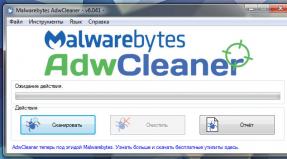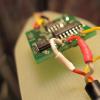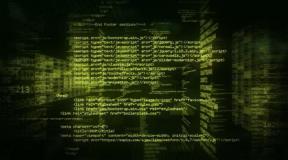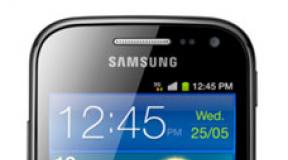Silicon power 8gb flash drive is not detected. Quick recovery of any Silicon Power flash drive. Determining the VID and PID of the USB controller
In our world, almost everything breaks, including flash drives from the company. Silicon Power- not an exception. The damage is very easy to notice. In some cases, some files begin to disappear from your storage device. Sometimes the drive simply ceases to be detected by the computer or any other device (it happens that it is detected by the computer, but not detected by the phone, or vice versa). Also, the memory card can be detected, but not opened, and so on.
In any case, it is necessary to restore the flash drive so that it can be used again. Unfortunately, in most cases you will not be able to recover any information and it will be permanently deleted. But after this, the USB drive can again be fully used and information can be written to it without fear that it will be lost somewhere. It is worth noting that removable media from Silicon Power very rarely last long after restoration; they still have to be replaced.
You can restore Silicon Power removable media using the programs that the company itself released. Besides this, there is something else software, which helps in this matter. We will analyze proven methods that have been tested by users from all over the world.
Method 1: Silicon Power Recover Tool
The first and most famous utility from Silicon Power. It has only one purpose - to fix damaged flash drives. Silicon Power Recover Tool works with removable media with Innostor IS903, IS902 and IS902E, IS916EN, and IS9162 series controllers. Its use is extremely simple and looks like this:
![]()
Method 2: SP ToolBox
The second proprietary program, which includes as many as 7 instruments. We only need two of them. To use Silicon Power ToolBox to recover your media, do the following:


The program can now be closed.
Method 3: SP USB Flash Drive Recovery Software
The third program from the manufacturer, which recovers flash drives from Silicon Power with great success. In fact, it performs the same process that users usually do using the iFlash service. Read about what it is and how to use it in the lesson on restoring Kingston flash drives.
The point of using this service is to find the desired program and use it to restore the flash drive. The search is carried out using parameters such as VID and PID. So, USB Flash Drive Recovery independently determines these parameters and finds the desired program on Silicon Power servers. Its usage looks like this:

Using this tool also does not make it possible to save the data contained in the drive's memory.
Method 4: SMI MPTool
This program Works with Silicon Motion controllers, which are installed in most Silicon Power flash drives. SMI MPTool differs in that it performs low-level recovery of damaged media. You can use it as follows:
- program and run it from the archive.
- Click on the button Scan USB" to start scanning your computer for a suitable flash drive. After this, your media should appear on one of the ports (column " Items"on the left). Click on it in this column to highlight it. Actually, if nothing happens, it means that the program is not suitable for your carrier.
- Next, click the “ Debug" If a window appears asking you to enter a password, enter the number 320.
- Now click the button Start" and wait for the restoration to complete.

In some cases, it helps if you do the above steps several times. In any case, it's worth a try. But, again, don’t expect data to be saved.
Method 5: Recuva File Recovery
Finally, we have reached a method that allows us to restore at least some of the damaged information. Only then will it be possible to restore the functionality of the device itself using one of the utilities described above. Recuva File Recovery is not SP's own development, but for some reason it is owned by this company. It is worth saying that this is not the same program that is familiar to all of us. All this only means that Recuva will be the most effective in working with flash drives from Silicon Power.
To take advantage of its capabilities, read the lesson on our website.
Only when you choose where to scan for deleted or damaged files, select the option “ On my media card"(this is step 2). If the card is not detected or no files are found on it, start the whole process again. Only now select the option “ In a specific location" and specify your removable media according to its letter. By the way, you can find it out if you go to “ My computer"(or simply " Computer», « This computer" - it all depends on the version of Windows). 
Method 6: Flash Drive Recovery
This is also a universal program that is suitable for most modern models removable storage media. Flash Drive Recovery is not developed by Silicon Power and is not listed among the recommended utilities on the manufacturer's website. But, judging by user reviews, it is extremely effective in working with flash drives from this manufacturer. Its usage looks like this:


In addition to Recuva File Recovery and Flash Drive Recovery, you can use TestDisk, R.saver and other utilities to recover data from damaged media. The most effective such programs are listed on our website.
After the recovery of lost data has been completed, use one of the above utilities to restore the functionality of the entire drive. You can also use the standard Windows tool to check disks and fix errors. How to do this is shown in the lesson on restoring Transcend flash drives (method 6).
Finally, you can format your removable media using other programs or the same standard means Windows. As for the latter, you need to do the following:
- In the window " Computer» (« My computer», « This computer") right-click on your flash drive. In the drop-down menu, select “ Format…».
- When the formatting window opens, click on the " Begin" If it doesn’t help, start the process again, but uncheck the box next to “ Quick…».

Also try using other disk formatting programs. The best of them are listed on our website. And if this doesn’t help, we won’t recommend anything other than buying a new media.
How to recover a Silicon Power flash drive
In our world, almost everything breaks and Silicon Power flash drives are no exception. The damage is very easy to notice. In some cases, some files begin to disappear from your storage device. Sometimes the drive simply ceases to be detected by the computer or any other device (it happens that it is detected by the computer, but not detected by the phone, or vice versa). Also, the memory card can be detected, but not opened, and so on.
In any case, it is necessary to restore the flash drive so that it can be used again. Unfortunately, in most cases you will not be able to recover any information and it will be permanently deleted. But after this, the USB drive can again be fully used and information can be written to it without fear that it will be lost somewhere. It is worth noting that removable media from Silicon Power very rarely last long after restoration; they still have to be replaced.
You can restore Silicon Power removable media using the programs that the company itself released. Apart from this, there are other software that help in this matter. We will analyze proven methods that have been tested by users from all over the world.
Method 1: Silicon Power Recover Tool
The first and most famous utility from Silicon Power. It has only one purpose - to fix damaged flash drives. Silicon Power Recover Tool works with removable media with Innostor IS903, IS902 and IS902E, IS916EN, and IS9162 series controllers. Its use is extremely simple and looks like this:
Download the utility, open the archive. Then open the folder AI Recovery V2.0.8.20 SP" and run the file RecoveryTool.exe from it.
![]()
Insert your damaged flash drive. When the utility is launched, it should automatically detect it and display it in the box labeled " Device" If this does not happen, choose it yourself. Try restarting the Silicon Power Recover Tool several times if the drive still doesn't show up. If nothing helps, then your media is not suitable for this program and you need to use another one. But if the media is displayed, just click the " Start
![]()
Method 2: SP ToolBox
The second proprietary program, which includes as many as 7 instruments. We only need two of them. To use Silicon Power ToolBox to recover your media, do the following:
Download latest version programs. To do this, go to the official Silicon Power website and below, opposite the inscription “,” click on the download icon. Below are links to download instructions for using SP ToolBox in PDF format, we don't need them.

Next you will be asked to log in or register. It’s convenient that you can log in to the site using your Facebook account. Enter your address Email in the appropriate field, check two boxes (“ I agree..." and "I read...") and click on the " Continue».

After this, the archive with the program we need will be downloaded. There is only one file in it, so open the archive and run it. Install SP ToolBox and launch it using the shortcut. Insert the flash drive and select it where it initially says “ No device" Do some diagnostics first. To do this, click on the button " Diagnostic Scan", and then " Full scan" to perform a full scan rather than a quick scan. Under the inscription " Scan result"The result of the check will be written. This simple procedure will allow you to find out whether your media is truly damaged. If there are no errors, most likely it is a virus. Then just scan your media with an antivirus and remove everything malware. If there are errors, it would be best to format the media.

For formatting there is a button " Secure Erase" Click on it and select the function " Full Erase" After this, all data will be erased from your storage device and it will restore its functionality. At least that's how it should be.

Also, for fun, you can use the health check function (that’s what it’s called) of the flash drive. There is a button for this Health" Click on it and you will see the status of your media under the inscription “ Health».
Critical- means critical condition;
Warming- not very good;
Good- implies that everything is fine with the flash drive.
Under the inscription " Estimated Life Remaining» You will see the approximate service life of the storage media you are using. 50% means that the flash drive has already served half of its life.

The program can now be closed.
Method 3: SP USB Flash Drive Recovery Software
The third program from the manufacturer, which recovers flash drives from Silicon Power with great success. In fact, it performs the same process that users usually do using the iFlash service. Read about what it is and how to use it in the lesson on restoring Kingston flash drives.
The point of using this service is to find the necessary program and use it to restore the flash drive. The search is carried out using parameters such as VID And PID. So, USB Flash Drive Recovery independently determines these parameters and finds the desired program on Silicon Power servers. Its usage looks like this:
Download USB Flash Drive Recovery from the company's official website. This is done in exactly the same way as in the case of SP ToolBox. Only if the system requires authorization again, remember that after registration you should have received a password by email, which you must use to log into the system. After authorization, download the archive, open it, then open the only folder that you will see on the screen several times (one folder inside another). Finally, when you reach the final folder, run the file " SP Recovery Utility.exe».
Then everything happens completely automatically. First, the computer is scanned for a Silicon Power flash drive. If one is detected, USB Flash Drive Recovery determines its parameters (VID and PID). Then she searches the servers for a suitable recovery program, downloads it and runs it. All you have to do is press the desired button. Most likely, the downloaded program will look like the image below. If so, just click on the “Recover” button and wait for the recovery to complete.

If nothing happens and all the above processes fail, perform them manually. If scanning does not start, which is highly unlikely, check the box next to the inscription “ Scan Device Information" The field on the right will begin to display relevant information about the ongoing process. Then check the box next to “ Download Recovery Tool Kit" and wait until the program downloads. Then unzip the archive - it's marked " Tool Kit UnZip"and use it, that is, run it - " Execution Tool Kit" Then the recovery utility will launch.
Using this tool also does not make it possible to save the data contained in the drive's memory.
Method 4: SMI MPTool
This program works with Silicon Motion controllers, which are installed in most Silicon Power flash drives. SMI MPTool differs in that it performs low-level recovery of damaged media. You can use it as follows:
Click on the button Scan USB" to start scanning your computer for a suitable flash drive. After this, your media should appear on one of the ports (column " Items"on the left). Click on it in this column to highlight it. Actually, if nothing happens, it means that the program is not suitable for your carrier.
Now click the button Start" and wait for the restoration to complete.

In some cases, it helps if you do the above steps several times. In any case, it's worth a try. But, again, don’t expect data to be saved.
Method 5: Recuva File Recovery
Finally, we have reached a method that allows us to restore at least some of the damaged information. Only then will it be possible to restore the functionality of the device itself using one of the utilities described above. Recuva File Recovery is not SP's own development, but for some reason it is located on the official website of this company. It is worth saying that this is not the same program that is familiar to all of us. All this only means that Recuva will be the most effective in working with flash drives from Silicon Power.
Only when you choose where you want to scan for deleted or damaged files, select the option " On my media card"(this is step 2). If the card is not detected or no files are found on it, start the whole process again. Only now select the option “ In a specific location" and specify your removable media according to its letter. By the way, you can find it out if you go to “ My computer”(or simply “Computer”, “This computer” - it all depends on the version of Windows).
Scan" at the bottom of the program window.

After this, the scanning process will begin. In the largest field you can see all the files and folders available for recovery. On the left there are two more fields - the results of a quick and deep scan. There may also be folders and files that can be recovered. To do this, highlight required file check mark and click the “Restore” button in the lower right corner of the open window.

After the recovery of lost data has been completed, use one of the above utilities to restore the functionality of the entire drive. You can also use the standard Windows tool to check disks and fix errors.
Finally, you can format your removable media using other programs or the same standard Windows tool. As for the latter, you need to do the following:
In the window " Computer"("My Computer", "This Computer"), right-click on your flash drive. In the drop-down menu, select “ Format…».
When the formatting window opens, click on the " Begin" If it doesn’t help, start the process again, but uncheck the box next to “ Quick…».

Good luck to you!
Step-by-step instructions for restoration USB flash drives in which I will try to answer the question in an accessible language How to recover a flash drive independently and without much effort.
Sometimes you help a person, and then he will tell everyone that you are so good and there are already crowds of people thirsty for help. This is roughly what happened when I restored several flash drives colleagues.
Now the people bear not only their own flash drives, but also flash drives your friends, acquaintances and relatives. Well, at least someone else would bring a bottle of beer or a cookie.
It’s not difficult for me to help, but when I suggest you learn how to do all this yourself, you refuse. Next time I’ll just sew them off. If you don't want to study, pass by.
I’ll finish with the lyrics here and move directly to the topic of the post..
If your flash drive stopped be determined like a disk, doesn't want to formatted, does not allow you to write down information or something else happened to it, BUT it has no mechanical damage, then you know that all is not lost. Most likely a glitch controller and you will have to tinker with it a little. This procedure takes approximately 5 minutes.
I’ll say right away that there is no universal programs For recovery all varieties flash drives. You will need to find exactly the one that can work with your controller. flash drives.
First we need to define VID And PID non-working flash drives.
Determine VID and PID for flash drive recovery
Stick it in flash drive into your computer and run device Manager. Start – Execute - mmc devmgmt.msc.

Then go to the section Universal Serial Bus Controllers.

We find ours in the list flash drive. Usually, everything flash drives have a name USB storage device.

Press the right button on the device and open Properties.

Go to the tab Intelligence.

Select the item from the drop-down list Instance code devices or Equipment IDs.

In this window we see PID And VID.

Finding a flash drive recovery program
We go to the website FlashBoot.ru and enter the received VID And PID.

Click on the button Search.
In the results we look for your manufacturer and model of the flash drive. I have Kingston DataTraveler 2.0.

The right column will contain the name of the program we need or a link to it.
All. Now search in Google program by name or download from the link provided. Launch and follow the instructions. Usually, in such programs for recovery There’s only one button, so you shouldn’t have any questions.
That's all!
If you have any questions, ask in the comments.
Losing information on a memory card is a very unpleasant thing. What if there was valuable information on the drives? Its loss can be a real tragedy, and a flash drive recovery utility can be a salvation. But before we describe the process of recovering information on a hard drive, let’s consider possible reasons loss of information on memory cards:
Drive software failure. If your flash drive does not open and asks to format it, this is exactly the case. It is usually caused by a crash of a special driver installed on any flash card. You can install it again, and then the drive’s functionality will be restored. However, the information will have to be restored separately. - Virus attacks. Yes, picking up a virus by transferring information from one PC to another is as easy as shelling pears. Some viruses specialize specifically in deleting/damaging files. - Mechanical damage. May be caused by temperature changes, shocks, falls, etc. In this case, the memory card may become completely unusable. But even in this case, it is possible to recover information! - Incorrect operation. A flash drive and/or information on it may be damaged in cases where: you do not use the “Safely Remove Hardware” option, remove the USB drive while downloading, recording information, watching movies, etc.
Flash drive recovery programs
How to recover information on a flash card? In almost all of the above cases we will be helped special utilities for flash drive recovery. There are a huge number of them now. We recommend that you use only proven software products. “Flash Drive Recovery 2.0” – powerful utility for flash drive recovery. She is capable of:
Recover information on storage devices different formats and manufacturing companies (Silicon Power, Kingston Datatraveler, Alcor Micro, Corsair Voyager) and any sizes (4gb, 8gb, 16gb, 32gb).
Work in cases where the flash drive has been formatted many times.
Recover information even on damaged memory cards.
Recover up to 100% of deleted information.
Flash drive recovery software can recover data from any type of storage device (music devices, digital cameras, flash drives, USB drivers, PC cards, etc.). This utility repairs all damaged and deleted files even if the memory card has been reformatted.
Read also...
- Cadaques in Spain. My review and photo. Cadaques, Catalonia Cadaques Spain how to get there from Barcelona
- Cart for an online store at the front or Writing modular javascript
- Falling snow on jQuery or html New Year greeting card template
- Where to see what version of Android is installed on an Honor and Huawei phone How to find out the Huawei serial number



















